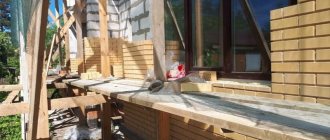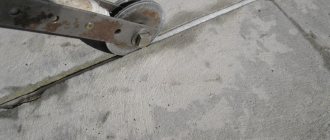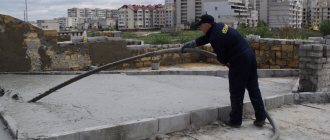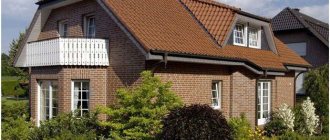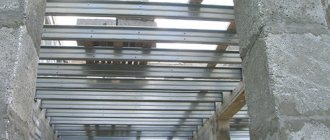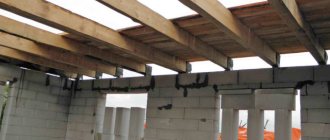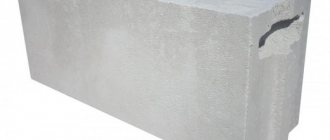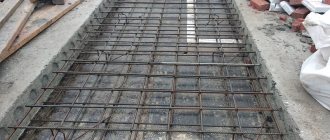Heat loss is a serious problem for any residential building. Heat loss occurs through door and window openings, roof, foundation and, of course, walls. In total, it is the walls that provide the maximum outflow of heat from the room, so various technologies that could reduce heating costs are in demand. The easiest way to properly insulate a facade is to do it with cladding insulation.
An excellent option for reducing heat loss
Effective insulation between the wall and facing brick
Heat loss is a serious problem for any residential building. Heat loss occurs through door and window openings, roof, foundation and, of course, walls. In total, it is the walls that provide the maximum outflow of heat from the room, so various technologies that could reduce heating costs are in demand. The easiest way to properly insulate a facade is to do it with cladding insulation.
Characteristic features of brick walls
In its properties, brick differs from other building materials. It is worth noting the following:
- Bricks can be either full or hollow - the choice of material directly depends on operational factors: the average temperature in the region, the load on the foundation, the chosen thermal insulation option.
- The format of the brickwork is also taken into account. The most common option is solid masonry, this method is the simplest. A more complex option is well masonry - in this case, so-called air pockets are made of bricks, and it is in them that the insulating material is placed.
- Alternatively, thermal insulation material can be installed between two layers of building material. This multi-layer structure consists of a load-bearing wall made of foam blocks, a layer of thermal insulation and a facing layer - the air space between the thermal insulation and the facing layer ensures the necessary air circulation.
- Since brick has good sound insulation properties, additional sound insulation for a brick facade is not needed.
Thermal insulation cake for insulating a brick house from the outside
In cross section, the insulated structure is represented by several layers. There are two methods of facade thermal insulation. “Wet” technology involves applying an adhesive layer to the brickwork. Then follow:
The ventilated façade is made without the use of water-containing solutions. Here, the insulation of a brick house from the outside is carried out using lathing made of wooden beams or a metal profile. In this case, the insulation on the wall side is covered with a vapor barrier membrane, with an outer layer that will protect the material from wind and moisture. A counter-lattice is assembled on top of the latter, which creates a ventilation gap and serves as a support for the cladding decor (panels, siding, lining).
Scheme for creating a thermal insulation cake for a brick wall
Advantages of insulation between block and brick
The main advantage of three-layer masonry with facing insulation under facing brick is cost-effectiveness - the cost of a house made of aerated concrete blocks with a brick lining will be significantly cheaper than a building made entirely of this building material. At the same time, the appearance of such a house remains at its best, and investments are minimal.
As for performance characteristics, we can note:
- good sound insulation;
- long service life;
- solid building;
- visual aesthetics.
It is worth clarifying that all these advantages are available only if the laying of building materials is done correctly, otherwise condensation will accumulate in the air opening, which will lead to rapid destruction of the masonry and insulation due to thermal expansion of the liquid.
How to fix errors
Incorrectly performed cladding is a common occurrence. Mistakes are made due to lack of knowledge or the desire to make the task easier for oneself. There is no hope for a favorable outcome, although there are often situations where aerated concrete walls with an incorrectly laid outer layer of brick work quite normally and do not cause any problems. The processes taking place in the wall pie mass are influenced by a huge number of factors. Their combination determines how acute the negative consequences of improper cladding will be.
If finishing aerated concrete with bricks with obvious errors is being done right now, it is best to stop the work and redo it as required by the technology. However, there are often situations where errors are discovered much later. For example, we bought a house with facing bricks. For some time the owner has no questions regarding the subtleties of finishing, but one day he becomes convinced that the choice of technique was incorrect. The situation is unpleasant, but not hopeless. As a rule, it is not possible to redo the cladding - to do this, you need to dismantle the brickwork and completely redo the cladding from the very beginning. Therefore, the issue is resolved in a different way.
Impenetrable wallpaper is installed on the inner surfaces of the walls, painted with oil paint, and impregnated with special compounds. At the same time, high-quality supply and exhaust ventilation is installed, ensuring intensive air exchange in the house. As a result, the walls are cut off from contact with air, and excess steam is removed using ventilation. If you monitor the condition of the equipment, prevent its downtime, and also keep the walls cut off from the internal atmosphere in order, you can get around the problem of improper cladding of the house.
Types of thermal insulation materials
The following options for insulating materials can be purchased on the market:
Mineral wool made from mineral fibers has good heat-saving properties. The manufacturing method involves breaking up molten minerals - it can be glass, slag or basalt. The material prepared in a centrifuge from thin mineral threads has a low density and is actually an air cushion, which has a low level of heat transfer. It is the air that prevents the penetration of cold through the layer of thermal insulation material. As for the properties of mineral wool, it demonstrates good heat-saving characteristics, but only in a dry state - when the mineral wool gets wet, it loses its properties. It is worth noting good fire safety - this facing insulation is non-flammable.
Expanded polystyrene is made from liquid polystyrene, which is saturated with air bubbles. It can be sold either in plates or in the form of round granules.
Due to the closed-cell structure, such material is less afraid of moisture, but fire safety is significantly lower than that of mineral wool. At high temperatures, the foam begins to melt and burns out completely, while the masonry may not even be damaged.
Bulk insulation is also suitable for thermal insulation when arranging three-layer masonry, instead of installing blocks, the crumbs are poured into internal wells. The base is expanded clay, slag and any other material that allows you to create a structure with a high air content. This option is significantly more affordable than using ready-made sheets of insulating materials, but is much worse in efficiency. This is due to the low thermal protection of expanded clay and slag. Crushed materials are also hygroscopic, which implies the need for good waterproofing - otherwise, water increases thermal conductivity and destroys layers of brick and aerated concrete.
Choosing insulation for brick walls
When choosing facing insulation, you need to familiarize yourself with the recommended list of options that comply with SNiP:
- We take into account the thermal conductivity indicator - the thermal insulation layer must ensure protection of the microclimate of the premises at the minimum temperatures typical for this region. On the packaging, the manufacturer must indicate the thermal insulation characteristics of the material, which makes it possible to calculate the required thickness of the insulation layer, taking into account winter temperatures.
- Good vapor permeability indicators - water entering the insulation should not accumulate inside it. Otherwise, its thermal insulation qualities are sharply reduced.
- Fire resistance is also a very important indicator that ensures fire safety; a layer of insulation can create a fireproof layer in the facade of a building.
Types of thermal insulation for insulating a brick house
An ignorant person is often faced with the question of which insulation is best for the walls of a brick house. This is justified by the wide range of materials offered. Let's look at the features and characteristics of popular options.
Foam and similar materials
Synthetic foam insulation belongs to the group of budget materials. Execution: rigid slabs with low weight due to high air content.
| Technical characteristics of polystyrene foam | ||
| Thermal conductivity | 0.036-0.050 W/m*K | |
| Density | 15-35 kg/cub.m | |
| Water absorption in 28 days | 4 % | |
| Vapor permeability | 0 mg/m*s**Pa | |
| Flammability class | G3, G4 | |
| Operating temperature range in Celsius | -50 — +70 degrees | |
| Life time | 25-35 years | |
The advantages of polystyrene foam are as follows:
Polystyrene foam has fewer disadvantages, but they can affect your decision.
The main disadvantages of polystyrene foam:
Insulation of the air gap of walls using polystyrene foam
Extruded polystyrene foam
An alternative to polystyrene foam is made by extrusion. The result is slabs with less air content and higher density, rigidity, and resistance to mechanical loads. But it costs more.
| Technical characteristics of extruded polystyrene foam | ||
| Thermal conductivity | 0.036-0.050 W/m*K | |
| Density | 28-45 kg/cub.m | |
| Water absorption in 28 days | 0,4 % | |
| Vapor permeability | 0.018 mg/m*s**Pa | |
| Flammability class | G3, G4 | |
| Operating temperature range in Celsius | -50 — +75 degrees | |
| Life time | 45-50 years | |
Compared to foam plastic, extruded polystyrene foam has fewer disadvantages.
The main disadvantages of EPS:
Wall insulation with extruded polystyrene foam
Minvata
Fibrous material is sold in the form of hard slabs or soft rolls. The basis for production can be glass, blast furnace slag, rocks.
| Technical characteristics of mineral wool | ||
| Thermal conductivity | 0.0326-0.05 W/m*K | |
| Density | 30-225 kg/cub.m | |
| Water absorption in 28 days | 6-30 % | |
| Vapor permeability | 0.3-0.54 mg/m*s**Pa | |
| Flammability class | NG, G1 | |
| Operating temperature range in Celsius | up to +100-700 degrees | |
| Life time | 30-50 years | |
Advantages of mineral wool as insulation
Mineral wool has fewer disadvantages, but they do exist. If you decide to insulate a brick house with your own hands, all the disadvantages must be taken into account.
Weaknesses of mineral wool as insulation
Insulation of a brick wall with mineral wool
Special thermal panels
The main advantage of the products is their decorative and thermal insulation function at the same time. The material consists of a layer of thermal insulation (polyurethane foam or polystyrene foam) and an outer shell made of artificial stone.
There are only two disadvantages
Installation of facade thermal panels is quite simple
Polyurethane foam
A subtype of plastic is a product of the oil refining industry. The composition may include natural oils (sunflower, soybean, rapeseed), but this affects the final cost. Insulation in dry form (slabs or hardened foam) has a porous structure with an air content of up to 90%.
In the construction industry, polyurethane foam with a density of 30-86 kg/cubic meter is used. Products weighing more than 70 kg per cubic meter are characterized by zero moisture absorption. But constant contact with water is contraindicated. The thermal conductivity coefficient depends on the size of the cells and ranges from 0.019 to 0.035 W/m*K.
Disadvantages of polyurethane foam as insulation
Insulation with warm plaster
Leveling mixtures are made based on cement binder with the addition of lime and plasticizers. The thermal insulation properties of the material are provided by filler in the form of granulated polystyrene foam and fine-grained expanded clay. The composition may also include vermiculite, sawdust or fibers, pumice in powder form, modified clay.
| Technical characteristics of dry residue | ||
| Thermal conductivity | 0.065 W/m*K | |
| Density | 200-300 kg/cub.m | |
| Water absorption per day | 70 % | |
| Flammability class | G1 | |
There are only two disadvantages
Applying warm plaster to a brick wall
Technology of insulation and wall cladding
In order to insulate the walls outside a building, it is not at all necessary to be a professional builder, the main thing is to strictly follow the recommendations.
Preparation of tools and materials
The choice of materials for home insulation is dictated by the local climate. Having decided on the insulation, you can choose tools - it could be a square, a building level, a trowel, a toothed trowel, etc.
Preparing the wall
Before starting work, it is necessary to prepare the facade for installation. To do this, the masonry is cleaned of dust and dirt, it is also necessary to seal the cracks and, if necessary, level the surface of the masonry. After this, we treat the facade with a primer.
It is necessary to take care of the leveling of the walls because after installing the insulation, the resulting voids in place of the cracks can become a place for deformation of the insulation - a small mechanical impact is enough for this. Also, it will not be possible to tightly glue the insulation onto the pits and tubercles.
Wall insulation
The technology of three-layer masonry with insulation and facing bricks contains the following steps:
- We lay out the inner wall - there is nothing complicated about it, since the masonry technology is the same as the masonry of any load-bearing wall. For it, either aerated concrete blocks or solid brick are selected. The thickness to the straight line depends on the minimum winter temperatures in the area and can be either 1 or 1.5 bricks.
- The next stage is laying out the outer wall with cladding. It is performed in such a way that a gap is formed between the walls - heat-insulating material is inserted into it. If granules are used, wells are formed for them. For strength, the walls are connected to each other with connections made of reinforcement and die-cuts. Alternatively, you can make a brick dressing at certain intervals.
- Waterproofing is an important step that will protect the insulation from moisture, which inevitably penetrates the brick layer. A thick film or roofing felt can be used as an insulator against moisture.
- Backfill thermal insulation material is poured into a niche as soon as the height of the wall reaches 1 m. If roll or sheet facing insulation is used, it is attached to the inner wall - for this, “mushrooms” with a large-diameter plastic cap are used. Having secured the insulation, we cover it with external facing masonry.
- For normal gas exchange, it is necessary to leave ventilation vents every 0.5-1 m - this is the name for the vertical seams between bricks, which are deliberately not filled with mortar.
As practice shows, three-layer masonry allows you to achieve several results at once and significantly improves the operation of the building in winter.
You can do it yourself, but it is better to turn to professionals, since errors in the technical process will negate all the advantages of this option for facade insulation.
Carrying out the necessary calculations before choosing insulation
To insulate the facade of a brick house, the first thing that needs to be considered is the thermal conductivity of the structures. You need to start with a table that shows data for regions. For example, in Moscow it is 3.14 sq.m*/W. Next, the value for the existing design is determined. For example, for hollow ceramic bricks it is 0.41 W/m*.
In order for the brickwork to comply with the standard, a wall with a thickness of 3.14 * 0.41 = 1.29 m will have to be erected. In order to save money, if in practice a structure of 0.5 m is laid out, then it is necessary to compensate 0.5 / 0.41 = 1.2 sq.m*/W. For cladding, for example, clinker bricks account for 0.012/0.8=0.015 sq.m*/W, which practically does not affect the total lack of conductivity of the walls, even with a thin layer of adhesive mortar.
After determining the thickness of a particular heat insulator, the issue of the total weight of the material on the supporting structures is considered. Only after this can you decide what methods will be used for installation and decorative finishing.
Preparing a brick wall for insulation
Any finishing work can be carried out provided there is a strong, dry, clean and “healthy” base. It is necessary to check the strength of the masonry mortar and the old wall covering, if any (paint, tiles, plaster, etc.). The latter is recommended to be completely dismantled.
If oily stains are present, they are treated with a degreaser. Areas affected by rust, fungus, mold or bacteria must be “cured” with exterminators and protected with preventative compounds. Cracks are fixed, faulty bricks are replaced, large chips are filled with leveling agent or tile adhesive. Finally, the surface is impregnated with a primer with antifungal additives for outdoor use.
Rules for cladding the walls of a house made of aerated concrete with bricks
Aerated concrete is a building material that is becoming increasingly relevant in the construction of residential premises. It became so popular due to its increased heat capacity, low weight and the absence of the need to pour a powerful foundation. However, the material is porous and afraid of moisture, so to protect against the negative effects of the environment, facing materials should be used. Cladding a house made of aerated concrete with brick is a more suitable method for those who have not yet chosen the type of finishing for the facade.
Pros and cons of aerated concrete walls lined with bricks
The most advantageous material that can be used to line aerated concrete is brick. The advantages of choosing it? Let's consider the advantages:
- Reliable protection from aggressive influences: snow, rain.
- Guarantee of high-quality sound insulation indoors.
- Presentable facade.
- The ability to withstand absolutely any natural phenomena due to the high strength of the structure.
- Aerated concrete walls are endowed with vapor permeability, which means the finishing should have exactly the same property, which brick perfectly matches.
- Brick increases the service life of a living space.
- Excellent frost resistance and mechanical strength.
Like other materials, aerated concrete walls have some disadvantages that are quite significant:
- If the gas blocks are laid with an air gap, then condensation will form in the wall cavity, which will cause the block to lose its properties much earlier.
- The need to generate additional money for the purchase of facing materials.
How to calculate the thickness of insulation for brickwork?
Insulation of walls with 2 bricks must be carried out with an accurate calculation of the amount of necessary materials. To minimize unnecessary costs and make the masonry of one and a half bricks warmer, it is necessary to accurately calculate the thickness of the insulation. Each building material used for the construction of external walls has its own characteristics. The basic requirements on the basis of which insulation material is selected are presented in the table:
| Main material | Thermal conductivity level | Required thickness of the insulating element, mm |
| Ceramic blocks | 0,17 | 575 |
| Aerated concrete blocks | 0,18 | 610 |
| Polystyrene concrete blocks | 0,19 | 643 |
| Expanded polystyrene | 0,042 | 124 |
| Glued laminated timber | 0,18 | 530 |
| Red clay brick | 0,76 | 2236 |
| Reinforced concrete | 2,04 | 6004 |
| Expanded clay concrete | 0,31 | 1049 |
Penoplex is a material that insulates a house on the same principle as expanded polystyrene.
Methods of facing walls with bricks
As it turned out, three options have been developed for cladding aerated block walls where brick is used: tightly to the walls, with an air gap, like a three-layer wall. They all differ in design and method of laying bricks. Let's take a closer look at each.
Close to the wall
This method is rarely in demand, because... relevant only for unheated rooms. If this method is implemented in buildings with heating, then the warm air, trying to escape to the street, will form condensation, which will serve as an impetus for the destruction of the wall from the outside.
It is impossible to rigidly connect brick and gas blocks, because they have completely different heat transfer coefficients, i.e. in heat or extreme cold they are subject to unequal expansion, and this will soon cause damage to the wall masonry.
With air gap without ventilation
This cladding method is considered durable because it increases the thermal insulation of walls. Please note that the method is relevant for structures without heating, because this type of masonry does not provide ventilation, as a result, the accumulated condensate will accumulate in the lowest part of the wall above the foundation. Builders recommend laying a layer of thermal insulation in the area between the brick and the gas block.
Three-layer wall with ventilated space
This type of masonry is considered the most optimal in terms of increased service life and technical characteristics of building materials. The three-layer option is: the first layer is aerated blocks, the second is space for ventilation, the third is brickwork. Creating such a wall is not easy, because it is a very complex process that requires the ability to correctly make calculations.
A brick wall is formed, where it is necessary to make through holes that serve as ventilation. There is a certain formula: per 10 square meters, 35 square centimeters of holes are made in any order (hole diameter is 1 centimeter). Builders recommend making holes in the seams between bricks.
The lower holes should be made with a slope towards the street side so that the condensate formed flows out onto the street.
There is also a technology for creating ventilation ducts. The bottom line is that the vertical seams between adjacent bricks are not filled with mortar, but plastic boxes with special holes are inserted into them. This is required for unhindered air circulation, and moisture escapes through the above holes.
When it’s time to lay insulation, you need to choose one that is not saturated with moisture and is breathable. An example of this is basalt wool.
Performing thermal insulation work
Technologies for carrying out installation work are selected based on the selected type of insulation and method of decorative finishing. In particular, with mortars or lathing. Let's look at the methods using examples of three groups of materials.
Using mineral wool
Fiber insulation is characterized by softness, so lathing is required here. The material is immersed in the cells and further strengthened by “fungi”. To protect the insulator, a water barrier is formed or a vapor-permeable membrane is laid. After filling the counter-lattice, decorative finishing is carried out using modern cladding materials.
Insulation of external walls with mineral wool
Foam insulation
If you plan to sheathe the walls, then the insulation technique is similar to when working with mineral wool. The only difference is the additional foaming of the installation gaps between the slabs and the sheathing. They are needed to compensate for the thermal expansion of dissimilar materials.
The second method is gluing the slabs with glue. Before this, the walls are leveled and primed with an adhesive compound. The solution is applied to the insulation or base in an even layer. The canvases are pressed using a rule in order to subsequently waste less leveling plaster. After the adhesive mass has dried, the insulator is additionally secured with dowels with a wide head (red “fungi” are considered the best).
Applying warm plaster
Preparation of the base is carried out by analogy with the method of insulating brick walls using the “wet” facade system. The difference is that warm plaster is applied to a previously wetted surface. The base is covered with reinforcing mesh. A homogeneous mixture is suitable for work within 1.5-2 hours.
Insulation of external walls with warm plaster
The distribution of the mass is carried out with a painting tool. Drying between layers takes approximately 4 hours. Complete drying of the finished coating occurs within 28 days.
Source
Insulation of gas blocks with facing brick lining
A house made of aerated concrete with brick cladding must be insulated. This is necessary not only for ideal heat retention in the building, but also to improve operating performance. So, there are several options for insulation and each should be considered separately:
- Expanded clay is a bulk insulation material that contains burnt clay granules.
- Mineral wool - includes mineral fibers. Builders recommend giving preference to the option that is produced in slabs. Important: mineral wool quickly becomes saturated with moisture, which means it needs waterproofing.
- Basalt wool - its base includes rock fibers. The insulation is highly resistant to fire and moisture, allowing air to pass through it perfectly. This type of wool is a convenient option for filling the open space between two walls.
- Penofol is a synthetic foil material. It has a small thickness, which is very important when the passage between the sheathing and the wall is too small.
- Expanded polystyrene is a budget option, but at the same time it is not saturated with moisture. The release form is slabs, making it easy to attach to the wall. Interestingly, this is the most popular material for insulating aerated blocks.
There is a certain procedure for installing insulation, depending on the type of materials. All types, with the exception of expanded clay, are installed before cladding. The cotton wool and polystyrene are fixed using special plastic umbrella dowels. When thermally insulated with expanded clay, it can be added, if necessary, during the process of creating the cladding.
To avoid seams between the constituent parts of the thermal insulation, they are sealed using sealant or polyurethane foam.
We insulate the walls from the inside
When using this method, you may encounter the following problems:
- destruction of foam concrete walls due to temperature changes (dew point inside the wall);
- condensation on the walls indoors - you need to use a vapor barrier and install a false wall;
- the appearance of cold bridges in places of contact with ceilings;
- internal insulation requires the use of insulation with improved environmental characteristics;
- risk of rodents appearing inside the insulation.
How to insulate the cracks (vents) between the brick and the block in an already built house? A more precise examination of the walls revealed a lack of insulation between the foam block and the brick. Is it possible to use liquid penoizol? Which brands are good and do not crumble during use? Which companies should I contact to avoid being deceived?
this is our house
I think I found it) From the Avito website, an offer of services.
Insulation and sound insulation (sound insulation) of houses, cottages, industrial premises, garages and containers by spraying and pouring polyurethane foam. PPU has the following properties: - has high mechanical strength, heat and frost resistance (from -100 to +150 ° C) - durable (the service life of PPU exceeds 30 years with full preservation of all properties) - resistant to moisture (weight absorption is only 2%) - has high and durable adhesion to almost all building materials - is not susceptible to microorganisms, mold and fungi, does not rot - provides anti-corrosion protection (by stopping the access of oxygen and moisture to the surface) They order from us: - comprehensive insulation of the house from foundation to roof; — sound insulation and thermal insulation of walls and ceilings; — insulation of attics and attics of houses; — thermal insulation of roofs of garages and industrial premises; — insulation of walls from the inside and outside; — insulation of floors from below and above. — thermal insulation of foundations. Insulation with polyurethane foam by spraying and pouring in Togliatti, Samara, Dimitrovgrad, Ulyanovsk Insulation of Hangar Insulation of Pavilion Insulation of Warehouse Insulation of Workshop Insulation of Frame House Insulation of Log House Insulation of Log House Insulation of Attic Insulation of Ceiling Insulation of Floor Insulation of Balcony, Loggia Ute captivity Entrance insulation Garage insulation Tanks insulation Pipeline insulation Insulation Vans and Kunguns Insulation of Vessels
COMPARISON TABLE 40 mm ppu = 2156 mm concrete 40 mm ppu = 1728 mm brick 40 mm ppu = 652 mm aerated concrete 40 mm ppu = 300 mm basalt min. plate 40 mm ppu = 250 mm mineral wool (mineral wool) 40 mm ppu = 183 mm polystyrene foam 40 mm ppu = 151 mm extruded polystyrene foam
Please leave a comment
Cladding technology
The technology for forming the cladding is slightly different and depends on the building in which it is created - a new one or an existing one. It is worth considering each of them in more detail.
During the construction of a new building
The foundation is laid across the entire thickness of the wall being built, i.e. for brick and gas block. Waterproofing the base is also done for the entire wall. Next you can start laying the walls. Decide for yourself what to put first: brick, gas block or all at the same time. But brickwork has a large number of seams in height, but you need to understand that they are noticeably thicker, but the blocks can generally be laid with glue. This creates a difference in shrinkage, but it is not significant unless we are talking about buildings with many floors.
Fastening aerated concrete and brick when cladding a new building
Fastening facing bricks to aerated concrete is done using conventional reinforcement. You can make it yourself from a rod or wire of the required diameter. In addition, steel tape is suitable for these purposes. But in any case, you need to pay attention to the following points:
- The sum of the cross-sectional areas of the reinforcement is no more than half a square centimeter per square meter of new masonry.
- The number of reinforcement products per square meter is 3-5 pieces.
- Near corners or openings at a distance of 20-25 cm, you need to make another row, the step of which is 25-30 cm.
Instead of connections, you can also use factory-made products, which at the same time provide for fastening the insulation.
When installing ties, it is necessary to ensure high-quality anchoring - that is, they should be immersed in the solution, alternating it at approximately a distance of 10 diameters.
Cladding the external walls of an existing building
In such a situation, it is necessary to build another foundation for the masonry. It doesn’t matter which type is chosen, the main thing is that it can cope with the additional load, i.e. withstood the walls, ceilings, roofing, etc., which are already supported by the foundation.
When forming such a cladding, the connections are secured with dowels. It is better to make through holes in the wall and mount the rods with washers from the inside. The rods can be attached to blind holes. Try not to use a standard solution; epoxy resin-based glue is suitable for this case.
Self-anchoring bolts are suitable for fastening, because they are almost instantly and quite efficiently attached to aerated concrete blocks and the seams located between them.
Mineral insulation - low-density cellular concrete
Recently, another type of insulation has been gaining popularity - products made from low-density cellular concrete. These are heat-insulating boards based on materials already known and used in construction - autoclaved aerated concrete, gas silicate.
Thermal insulation slabs made of cellular concrete have a density of 100 - 200 kg/m3 and a dry thermal conductivity coefficient of 0.045 - 0.06 W/mOK. Mineral wool and polystyrene foam insulation have approximately the same thermal conductivity. Slabs with a thickness of 60 - 200 mm are produced. Compressive strength class B1.0 (compressive strength not less than 10 kg/m3.) Vapor permeability coefficient 0.28 mg/(m*year*Pa).
Thermal insulation slabs made of cellular concrete are a good alternative to insulation made from mineral wool and expanded polystyrene.
Well-known brands of thermal insulation slabs made of cellular concrete in the construction market: “Multipor”, “AEROC Energy”, “Betol”.
Advantages of thermal insulation slabs made of cellular concrete:
Household products
⇆
The most important thing is higher durability. The material does not contain any organic matter - it is an artificial stone. It has a fairly high vapor permeability, but less than mineral wool insulation.
The structure of the material contains a large number of open pores. The moisture that condenses in the insulation in winter dries quickly in the warm season. There is no moisture accumulation.
Thermal insulation does not burn and does not emit harmful gases when exposed to fire. The insulation does not cake. Insulation boards are harder and mechanically stronger.
The cost of insulating a facade with cellular concrete slabs, in any case, does not exceed the cost of thermal insulation with mineral wool insulation or expanded polystyrene.
When installing heat-insulating slabs made of aerated concrete, the following rules are followed:
Thermal insulating slabs made of aerated concrete up to 100 mm thick are attached to the facade using glue and dowels, 1-2 dowels per slab.
A wall made of slabs more than 100 mm thick is laid close to the insulated wall. The masonry is laid using glue with a seam thickness of 2-3 mm. The masonry of insulation boards is connected to the load-bearing wall with anchors - flexible ties at the rate of five ties per 1 m2 of wall. A technological gap of 2-15 mm can be left between the load-bearing wall and the insulation.
It is better to connect all layers of the wall and brick cladding with a masonry mesh. This will increase the mechanical strength of the wall.
Recommendations for cladding
Brick lining of aerated concrete blocks is a complex job consisting of three stages, which are worth considering in more detail:
- Pouring the foundation.
- Selection of bricks.
- Formation of brickwork.
Laying the foundation
This is the main point that needs to be thought through initially, i.e. even before construction starts. Here it is necessary to take into account three nuances: the width of the gas block, insulation and brick for cladding. A prerequisite is that the cladding should not hang over the edges, i.e. the width of the foundation should be the sum of the three above components.
Brick selection
The aerated block must be lined with brick, mounted to its width, in other words, to half a brick. The manufacturing material can be hollow, clinker, solid and silicate. Most often in practice, clinker or hollow bricks are used. The first method is much more expensive, but it also has many positive qualities:
- high compressive strength;
- Clinker frost resistance is much better than ordinary facing brick;
- attractive appearance;
- low water absorption (5%) compared to conventional bricks (about 13%).
Brick laying
The final stage of cladding, which includes several stages with many important points. To reliably protect the foundation from condensation, you should lay it on a layer of rolled waterproofing. The remaining rows are placed on a pre-prepared mortar so that the seams in the previous row are densely filled. For masonry you will need a metal rod with a diameter of 0.8-1 cm. Place it outside. A similar rod is used to create a vertical seam.
The mortar is laid out on the formed row and the next brick is laid. When moving the row, do not forget to move the rod along it.
Remember that reinforcement is required for several rows. For shaping, a synthetic mesh is suitable, which can be cut into strips 8 cm wide. As the solution hardens, it may be necessary to undo the seams. First, they are filled with a solution, and after its formation, jointing is done using a special tool.
